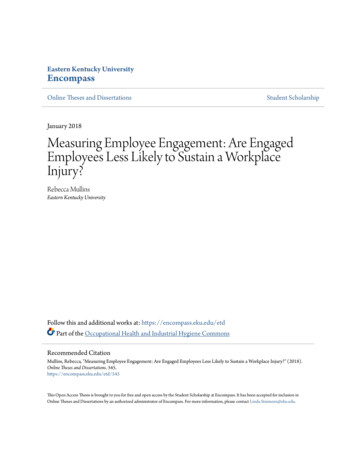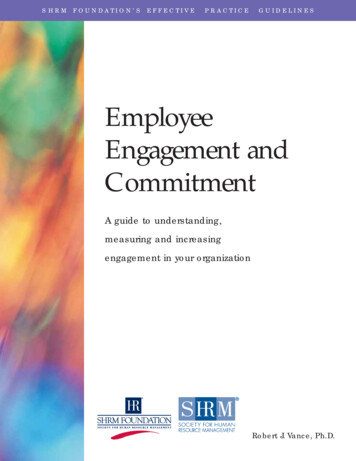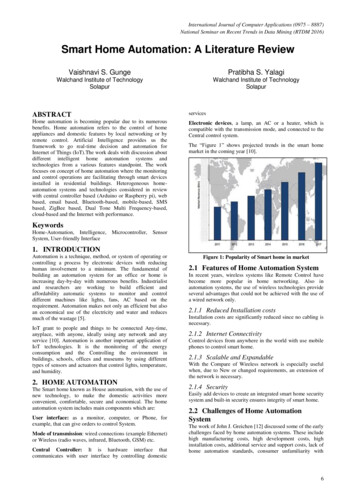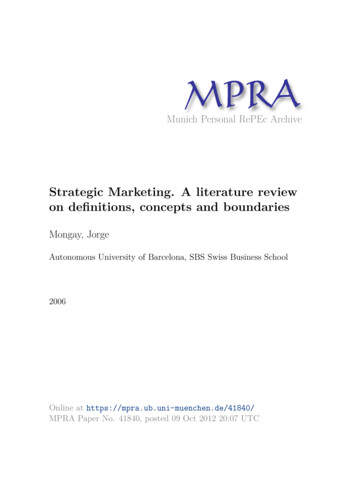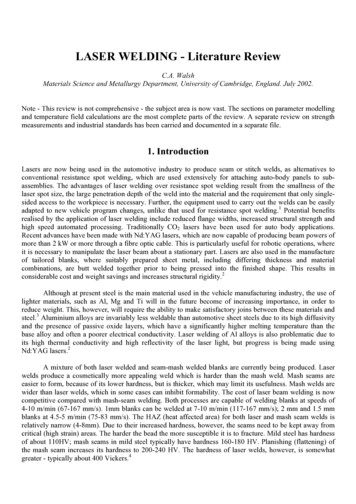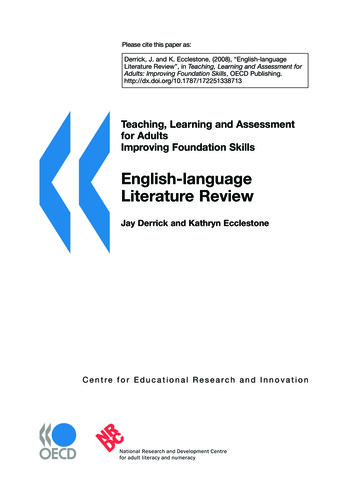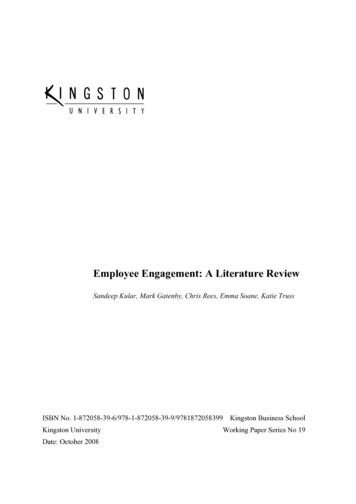
Transcription
Employee Engagement: A Literature ReviewSandeep Kular, Mark Gatenby, Chris Rees, Emma Soane, Katie TrussISBN No. 1-872058-39-6/978-1-872058-39-9/9781872058399 Kingston Business SchoolKingston UniversityDate: October 2008Working Paper Series No 19
2
ContentsPageContactiForewordiiIntroduction1Part 1:Conceptualising Employee Engagement3Defining EngagementResearching EngagementAntecedents and Consequences of EngagementEmployee Engagement in Context3467Part 2:Engagement and Indivdiual Differences10Part 3:Engagement and Employee Involvement15Part 4:Summary and Conclusions18Part 5:Recommendations20References23i
ContactSandeep KularMark GatenbyChris ReesEmma SoaneKatie TrussKingston Business SchoolKingston UniversityKingston HillKingston upon ThamesSurrey KT2 7LBe-mail: k.truss@kingston.ac.ukii
ForewordThis working paper reports the findings of a literature review dissertation undertaken bySandeep Kular in 2007, which formed part of her MA Human Resource Management degreeat Kingston University. The dissertation contributed towards the development of a conceptualframework for the establishment of the Kingston Business School Employee EngagementConsortium, a research partnership aimed at developing knowledge and understanding ofemployee engagement, its drivers, and its consequences.Our interest in employee engagement began in 2006, when we were approached by theChartered Institute of Personnel and Development (CIPD) to undertake a survey of levels ofengagement in the UK workforce. Our findings were published in the CIPD report WorkingLife: Employee Attitudes and Engagement (Truss et al 2006). We found that levels ofengagement nationally were low, but that high levels of engagement were associated with ahost of positive outcomes for individuals and their employers. Our study revealed the value ofengagement, but we wanted to know more about how engagement levels vary across differentsectors and contexts. Sandeep’s work formed part of the next steps in developing this furtherresearch process.The Consortium is now moving ahead with sharing knowledge and developing new insightsinto the nature of employee engagement and its impact on organisations.Five key areas are being explored: What does ‘employee engagement’ mean?; How canengagement be managed?; What are the consequences of engagement for organisations?; Howdoes engagement relate to other individual characteristics?; How is engagement related toemployee voice and representation? Sandeep’s dissertation involved exploring some of therelevant literature around each of these issues. Specifically she focused on three keyquestions:1. How has employee engagement been conceptualised?2. How do individual differences relate to employee engagement?3. How does employee involvement relate to employee engagement?This working paper summarises a broad range of academic literature under each of theseheadings. We found it a useful contribution to our subsequent work, and we are grateful toSandeep for pursuing her dissertation research with such depth and rigour. I trust it will be ofinterest to anyone wishing to know more about this increasingly important area ofmanagement practice.Professor Katie TrussDirector, Kingston Business School Employee Engagement Consortiumiii
IntroductionEmployee engagement has become a hot topic in recent years. Despite this, there remains apaucity of critical academic literature on the subject, and relatively little is known about howemployee engagement can be influenced by management. Although there is a great deal ofinterest in engagement, there is also a good deal of confusion. At present, there is noconsistency in definition, with engagement having been operationalised and measured inmany disparate ways.This literature survey examined peer-reviewed journal articles, working papers, textbooks,and other published resources relevant to employee engagement. Articles were found throughthe search facility of on-line journal databases such as EBSCO Business Source Premier,Emerald Full text and ABI Inform. The review indicates that there are more employees whoare disengaged or not engaged than there are engaged employees. Despite this, manyorganisations believe that engagement is a dominant source of competitive advantage. Resultsfrom research organisations and corporate results have demonstrated there may be a stronglink between engagement, employee performance and business outcomes. The key drivers ofemployee engagement identified include communication, opportunities for employees to feedtheir views upwards and thinking that their managers are committed to the organisation.Whilst key drivers of engagement have been identified it is also clear that ‘one size does notfit all’.The review also identifies gaps and issues that have not so far been investigated, making clearthe focus of where further enquiry should be. It is apparent that there is a lack of researcharound the predictors of engagement and whether or not interventions, such as trainingmanagers on how to communicate effectively, could help to increase engagement. There isalso a need for future research to concentrate on individual differences and whether variablessuch as personality impact engagement. Finally, much of the research has been conducted inthe US, therefore future research must further explore other countries where less is knownabout engagement levels.The review aims to add value to the current state of knowledge by critically evaluating theexisting literature on employee engagement and providing a reflective stance on existingdebates and findings. As a result, it addresses concerns about the lack of agreement on whatengagement is and how issues surrounding it can be addressed.Research by the CIPD has repeatedly demonstrated the links between the way people aremanaged, employee attitudes and business performance (Purcell 2006 and Truss et al 2006).Moreover, engaged employees have been found to outperform their disengaged counterparts.However, recent research in the UK and other countries shows that there are more disengagedemployees than there are engaged employees in today’s organisations. Employee engagementcan and has been found to make a difference. However there is great disagreementsurrounding how to define engagement, how it should be operationalised and whether or not itis actually a valid construct at all. Furthermore, it is evident that sound, academic researchlags somewhat behind practice given that the literature is under developed, and the concept ofengagement is still in its infancy.The review addresses three sets of key questions in turn, as follows:1
1.How has employee engagement been conceptualised?1.11.21.31.41.51.62.How do individual differences relate to employee engagement?2.12.22.33.What is employee engagement?How has it been defined?How has it been operationalised?What are the constituent elements of employee engagement?What evidence is there about levels of employee engagement? (UK andworldwide)What are the suggested antecedents and consequences of employee engagement?How is employee engagement related to how work is perceived?To what extent is engagement related to emotional experiences and wellbeing, andwhy?How does engagement influence outcome variables?How does employee involvement relate to employee engagement?3.13.23.3What kinds of voice mechanisms seem to offer employees a greater sense ofinvolvement?What evidence is there of mutual decision-making and problem solving?To what extent are management willing to share control with employees?2
Part 1: Conceptualising Employee EngagementDefining EngagementOne of the first challenges presented by the literature is the lack of a universal definition ofemployee engagement. Kahn (1990:694) defines employee engagement as “the harnessing oforganization members’ selves to their work roles; in engagement, people employ and expressthemselves physically, cognitively, and emotionally during role performances”. The cognitiveaspect of employee engagement concerns employees’ beliefs about the organisation, itsleaders and working conditions. The emotional aspect concerns how employees feel abouteach of those three factors and whether they have positive or negative attitudes toward theorganisation and its leaders. The physical aspect of employee engagement concerns thephysical energies exerted by individuals to accomplish their roles. Thus, according to Kahn(1990), engagement means to be psychologically as well as physically present whenoccupying and performing an organisational role.Most often employee engagement has been defined as emotional and intellectual commitmentto the organisation (Baumruk 2004, Richman 2006 and Shaw 2005) or the amount ofdiscretionary effort exhibited by employees in their job (Frank et al 2004). Although it isacknowledged and accepted that employee engagement is a multi-faceted construct, aspreviously suggested by Kahn (1990), Truss et al (2006) define employee engagement simplyas ‘passion for work’, a psychological state which is seen to encompass the three dimensionsof engagement discussed by Kahn (1990), and captures the common theme running throughall these definitions.The existence of different definitions makes the state of knowledge of employee engagementdifficult to determine as each study examines employee engagement under a differentprotocol. In addition, unless employee engagement can be universally defined and measured,it cannot be managed, nor can it be known if efforts to improve it are working (Ferguson2007). This highlights the problems of comparability caused by differences in definition.Furthermore, whilst it is acknowledged that employee engagement has been defined in manydifferent ways, it is also argued the definitions often sound similar to other better known andestablished constructs such as ‘organisational commitment’ and ‘organisational citizenshipbehaviour’ (OCB) (Robinson et al 2004). Thus Robinson et al (2004) defined engagement as‘one step up from commitment’. As a result, employee engagement has the appearance ofbeing yet another trend, or what some might call “old wine in a new bottle”.Engagement vs Other ConstructsIt would appear that there are sufficient grounds for arguing that engagement is related to, butdistinct from, other constructs in organisational behaviour (Saks 2006). For example,Robinson et al (2004) state that:“ engagement contains many of the elements of both commitment and OCBbut is by no means a perfect match with either. In addition, neithercommitment nor OCB reflect sufficiently two aspects of engagement - its twoway nature, and the extent to which engaged employees are expected to havean element of business awareness.”3
Saks (2006) argues that organisational commitment also differs from engagement in that itrefers to a person’s attitude and attachment towards their organisation, whilst it could beargued that engagement is not merely an attitude; it is the degree to which an individual isattentive to their work and absorbed in the performance of their role. In addition, while OCBinvolves voluntary and informal behaviours that can help co-workers and the organisation, thefocus of engagement is one’s formal role performance rather than purely extra-role andvoluntary behaviour.According to May et al (2004) engagement is most closely associated with the constructs ofjob involvement and ‘flow’ (Csikszentmihalyi 1990). Job involvement is defined as ‘acognitive or belief state of psychological identification’ (Kanungo 1982:342). This differsfrom engagement in that it is concerned more with how the individual employs him/her selfduring the performance of his/her job. Furthermore, whilst the focus of job involvement is oncognitions, engagement, according to most definitions, also encompasses emotions andbehaviours.The second related construct, the notion of ‘flow’, is defined as the “holistic sensation thatpeople feel when they act with total involvement” (Csikszentmihalyi 1975:36). It is arguedthat individuals in a flow experience need no external rewards or goals to motivate them, asthe activity itself presents constant challenges (ibid). However, whilst flow is primarily thecognitive involvement of the individual in an activity on a momentary basis, definitions ofengagement imply a longer-term and more holistic involvement in work tasks (Kahn, 1990;Holbeche and Springett, 2003).Researching EngagementOne of the most influential studies of engagement was carried out by Kahn (1990).Conceptually, Kahn began with the work of Goffman (1961) who proposed that, “people’sattachment and detachment to their role varies” (Kahn 1990:694). However, Kahn argued thatGoffman’s work focused on fleeting face-to-face encounters, while a different concept wasneeded to fit organisational life, which is “ongoing, emotionally charged, and psychologicallycomplex” (Diamond and Allcorn 1985).To gain further understanding of the varying levels of attachment individuals expressedtowards their roles, Kahn (1990) examined several disciplines. It was found that psychologists(Freud 1922), sociologists (Goffman 1961, Merton 1957) and group theorists (Slater 1966,Smith and Berg 1987) had all recognised the idea that individuals are naturally hesitant aboutbeing members of ongoing groups and systems. As a result they “seek to protect themselvesfrom both isolation and engulfment by alternately pulling away from and moving towardstheir memberships” (Kahn 1990). The terms Kahn (1990) uses to describe these calibrationsare ‘personal engagement’ and ‘personal disengagement’, which refer to the “behaviours bywhich people bring in or leave out their personal selves during work role performances”(Kahn 1990:694). These terms developed by Kahn (1990) integrate previous ideas taken frommotivation theories that people need self-expression and self-employment in their work livesas a matter of course (Alderfer 1972, Maslow 1954).Kahn undertook a qualitative study on the psychological conditions of personal engagementand disengagement by interviewing summer camp counsellors and staff at an architecture firmabout their moments of engagement and disengagement at work. He defined disengagementas the decoupling of the self within the role, involving the individual withdrawing and4
defending themselves during role performances (May et al 2004). Disengaged employeesdisplayed incomplete role performances and were effortless, automatic or robotic (Kahn1990). Kahn found that there were three psychological conditions related with engagement ordisengagement at work: meaningfulness, safety, and availability. He argued that people askedthemselves three fundamental questions in each role situation: (i) How meaningful is it for meto bring myself into this performance; (ii) How safe is it to do so?; and (iii) How available amI to do so? He found that workers were more engaged at work in situations that offered themmore psychological meaningfulness and psychological safety, and when they were morepsychologically available.In the only study to empirically test Kahn’s (1990) model, May et al (2004) found thatmeaningfulness, safety, and availability were significantly related to engagement. They alsofound job enrichment and role fit to be positive predictors of meaningfulness; rewarding coworker and supportive supervisor relations were positive predictors of safety, while adherenceto co-worker norms and self-consciousness were negative predictors. Resources were apositive predictor of psychological availability, while participation in outside activities was anegative predictor. Overall, meaningfulness was found to have the strongest relation todifferent employee outcomes in terms of engagement.An alternative model of engagement comes from the ‘burnout’ literature, which describes jobengagement as the positive antithesis of burnout, noting that burnout involves the erosion ofengagement with one’s job (Maslach et al 2001). According to Maslach et al, six areas ofwork-life lead to either burnout or engagement: workload, control, rewards and recognition,community and social support, perceived fairness and values. They argue that job engagementis associated with a sustainable workload, feelings of choice and control, appropriaterecognition and reward, a supportive work community, fairness and justice, and meaningfuland valued work. Like burnout, engagement is expected to mediate the link between these sixwork-life factors and various work outcomes. May et al’s (2004) findings support Maslach etal’s (2001) notion of meaningful and valued work being associated with engagement, andtherefore it is important to consider the concept of ‘meaning’.According to Holbeche and Springett (2003), people’s perceptions of ‘meaning’ with regardto the workplace are clearly linked to their levels of engagement and, ultimately, theirperformance. They argue that employees actively seek meaning through their work and,unless organisations try to provide a sense of meaning, employees are likely to quit. Theresearch findings suggest that many people experience a greater search for meaning in theworkplace (70 per cent) than in life in general (ibid). There are numerous possible reasons forthis, for example, it may be because people generally spend longer at work than on other partsof their lives. Holbeche and Springett (2003) argue that high levels of engagement can only beachieved in workplaces where there is a shared sense of destiny and purpose that connectspeople at an emotional level and raises their personal aspirations.Kahn’s (1990) and Maslach et al’s (2001) models indicate the psychological conditions orantecedents that are necessary for engagement, but they do not fully explain why individualswill respond to these conditions with varying degrees of engagement. According to Saks(2006), a stronger theoretical rationale for explaining employee engagement can be found insocial exchange theory (SET). SET argues that obligations are generated through a series ofinteractions between parties who are in a state of reciprocal interdependence. A basicprinciple of SET is that relationships evolve over time into trusting, loyal, and mutualcommitments as long as the parties abide by certain ‘rules’ of exchange (Cropanzano and5
Mitchell 2005). Such rules tend to involve reciprocity or repayment rules, so that the actionsof one party lead to a response or actions by the other party. For example, when individualsreceive economic and socio-emotional resources from their organisation, they feel obliged torespond in kind and repay the organisation (ibid). This is consistent with Robinson et al’s(2004) description of engagement as a two-way relationship between the employer andemployee.Saks (2006) argues that one way for individuals to repay their organisation is through theirlevel of engagement. In other words, employees will choose to engage themselves to varyingdegrees and in response to the resources they receive from their organisation. Bringingoneself more fully into one’s work roles and devoting greater amounts of cognitive,emotional, and physical resources is a very profound way for individuals to respond to anorganisation’s actions, as suggested earlier by the work of Kahn (1990). Thus, employees aremore likely to exchange their engagement for resources and benefits provided by theirorganisation.In summary, SET provides a theoretical foundation to explain why employees choose tobecome more or less engaged in their work and organisation. In terms of Kahn’s (1990)definition of engagement, employees feel obliged to bring themselves more deeply into theirrole performances as repayment for the resources they receive from their organisation. Whenthe organisation fails to provide these resources, individuals are more likely to withdraw anddisengage themselves from their roles. Thus, the amount of cognitive, emotional, and physicalresources that an individual is prepared to devote in the performance of their work role maybe c
Consortium, a research partnership aimed at developing knowledge and understanding of employee engagement, its drivers, and its consequences. Our interest in employee engagement began in 2006, when we were approached by the Chartered Institute of Personnel and Development (CIPD) to undertake a survey of levels of engagement in the UK workforce.


